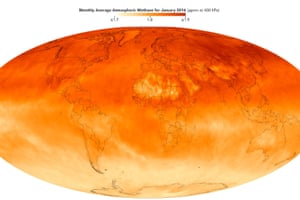Governments have drastically underestimated methane emissions from natural gas and will miss the Paris agreement’s goal of limiting global warming to 2C unless they urgently scale down its use, a major new study has found.
Continuing natural gas emissions at present levels will add 0.6C to global warming and, with other fossil fuel use, exhaust Europe’s carbon budget – the amount it can safely and fairly emit – in less than a decade, says the report by the Tyndall Centre for Climate Change Research.
It concludes that Europe must phase out all fossil fuels including gas by 2035 and decrease emissions by 12% per year – far beyond its current ambitions – to keep to the Paris 2C pledge.
EU countries, including the UK, have committed to burn more natural gas as a “bridging fuel”, because it offers a baseline alternative to wind and solar on cloudy and windless days, and because it emits less carbon dioxide than coal.
“Considering both carbon dioxide and methane emissions, an urgent programme to phase out existing natural gas and other fossil fuel use across the EU is an imperative of any scientifically informed and equity-based policies designed to deliver on the Paris agreement,” says the study, which was co-written by Tyndall’s Prof Kevin Anderson and Dr John Broderick.
Their report, which is based on original modelling and a meta-analysis of 250 gas supply chain studies, logs a “sustained rise” since 2006 in atmospheric methane concentrations. These are now “at the top end of IPCC (Intergovernmental Panel on Climate Change) scenarios” and running at unsustainable levels, according to the study.
Far from phasing out natural gas ventures though, the EU appears to be accelerating them in a new “projects of common interest” (PCI) list for gas infrastructure.
After 77 gas projects were approved in the last PCI round, the latest slate (pdf) could potentially approve more than 100 gas ventures for public funding and fast-tracked planning approval, according to analysis by Friends of the Earth Europe (FoEE).
The projects were evaluated on the basis of forecasts by the European network of transmission systems operators for gas, a coalition of gas companies and their subsidiaries.
In 2016, Europe’s gas industry spent more than €100m (£89m) and employed more than 1,000 lobbyists in an effort to promote gas as a relatively clean fossil fuel, according to a report published last week.
Antoine Simon, an FoEE spokesman said: “It is intolerable to see the European commission and its members giving support to an increasing number of gas projects that will lock us in to decades of fossil fuel addiction. As the UN reminded us last week, we are currently paving the way to a 3C temperature rise. Facing the prospect of being ‘toasted, roasted and grilled’, it is unconscionable that the EU is turning its back on the urgent climate action needed to remedy this situation.”
Methane is a powerful greenhouse gas, about 30 times more potent than carbon dioxide, that may still push global warming past “tipping points” beyond which it becomes irreversible.
It exists naturally in water-borne micro-organisms, agriculture and methane hydrates – some already thawing as the climate warms – and is produced in bulk by measured gas emissions, and non-measured leaks.
Uncertainties remain about the exact attribution of atmospheric methane, but recent studies estimate that anthropogenic sources caused between 48-65%, with fossil fuels accounting for about a third of the total.
“Extracting and burning natural gas produces substantial quantities of methane and carbon dioxide which warm the climate in different ways,” Broderick said. “We need to rapidly reduce emissions of both of these gases to prevent dangerous climate change, not one or the other.”

No comments:
Post a Comment